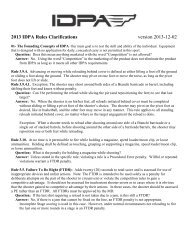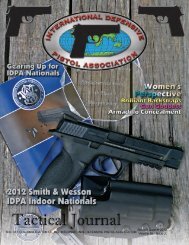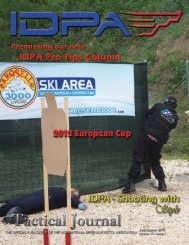Volume: 16, Issue: 4 (4th Quarter 2012) - IDPA.com
Volume: 16, Issue: 4 (4th Quarter 2012) - IDPA.com
Volume: 16, Issue: 4 (4th Quarter 2012) - IDPA.com
You also want an ePaper? Increase the reach of your titles
YUMPU automatically turns print PDFs into web optimized ePapers that Google loves.
Check out the shooter’s<br />
condition to make sure he has<br />
all his equipment ready to go.<br />
sure his shoelaces are tied. Check<br />
out to see if there is any clothing that<br />
will hang up in the holster. Make<br />
sure the holster’s tension screws are<br />
not missing. Check to see that his<br />
eye and ear protection is in place. If<br />
the stage requires concealment, be<br />
sure he has his vest with him. This<br />
can be<strong>com</strong>e part of your SO routine<br />
and it will prevent problems before<br />
they happen.<br />
When the shooter is finished<br />
shooting the Course of Fire, the SO<br />
needs to stay focused. I have seen<br />
SO’s start reading the time off the<br />
timer and scoring targets while the<br />
shooter still has his gun out. The SO<br />
must stay focused on the shooter’s<br />
firing hand and gun until that gun<br />
is put away. Once the gun is safely<br />
holstered, then the SO will read the<br />
time and score the targets.<br />
Shooters need to be instructed to<br />
be mindful of the gun during of the<br />
Unload and Show Clear Process.<br />
The gun must be cleared and put<br />
away before the shooter goes about<br />
picking up dropped magazines and<br />
ejected rounds. The shooter should<br />
not be picking up these things with<br />
a gun in his hand. Make the gun safe<br />
before policing the range for other<br />
items.<br />
Match Directing:<br />
I had a recent discussion with an<br />
MD who has an interest in making<br />
sure he has stages “for the Master<br />
Class Shooters”. He wanted to create<br />
stages that were challenging to the<br />
MA shooters. They were indeed fun<br />
for the MA shooters, but I witnessed<br />
many SS and MM shooters walking<br />
away from the stage very unhappy.<br />
What was a tough array for a<br />
Master became either a procedural<br />
trap or a -20 nightmare for the SS<br />
and MM shooters. Several of the<br />
MM shooters admitted later they<br />
willingly took a PE as it was the only<br />
way they could make the hits. What<br />
was intended as a fun stage for the<br />
MA shooters was instead something<br />
the rest of the <strong>com</strong>petitors just had<br />
to survive and maybe even cheat<br />
their way through.<br />
<strong>IDPA</strong> Match Directors are in the<br />
entertainment business. They need<br />
to make stages that are fun for<br />
USE ISMI, WOLFF OR SINGLE STAGE RECOIL SPRINGS IN YOUR GEN 4!<br />
GUIDE RODS FOR GEN 4 GLOCKS!<br />
POLYMER GUIDE RODS • BLACK STEEL GUIDE RODS & more!<br />
JAGER YOUR GLOCK TODAY!<br />
www.jagerproducts.<strong>com</strong> • (5<strong>16</strong>) 859-2508<br />
ULTRA-LIGHT STRIKERS • COMPENSATORS • OPEN DIVISION KITS<br />
Run a Better Match<br />
shooters of all classifications and<br />
divisions. So how can you make<br />
a stage with a little something for<br />
everyone? Try to make a stage with<br />
a choice to make. Set up a stage<br />
with a disappearing target that has<br />
a nearby static target. The MA and<br />
EX shooters can take on the static<br />
target before the disappearing target<br />
activates. The less experienced<br />
shooters can take the safe route<br />
and wait for the disappearing target<br />
to activate, and then move on to<br />
the static target. The MA and EX<br />
shooters can pick up time (or crash<br />
and burn) and the less experienced<br />
shooters will not feel robbed.<br />
Another way is to offer a choice<br />
is to have a stage with more than<br />
one way through it. One choice<br />
gives the shooter an opportunity to<br />
engage targets from a distance or<br />
with a tough Non-Threat target in<br />
the way. If the shooter chooses to,<br />
he can move about the stage and<br />
engage the targets from a closer<br />
range and without the Non-Threat in<br />
the way. The shooter has to choose<br />
between making a tight shot or he<br />
must spend more time on the clock<br />
moving to the other position.<br />
It is not always easy to make up<br />
a stage that offers choices to the<br />
shooter. <strong>IDPA</strong>’s Course of Fire rules<br />
and 18 shots or less round count can<br />
be limiting in this regard. But it can<br />
be done and should be attempted.<br />
Give the hot dogs a chance to shine<br />
while giving the rest of us a fun<br />
match to shoot.<br />
In a previous column I discussed<br />
the features in a stage that can cost<br />
time. These are things added to a<br />
stage that will cost time during the<br />
reset, or Load and Make Ready<br />
portion of the stage. Moving targets,<br />
some props, and activators cost time<br />
during the reset process. Special<br />
instructions such as lying down on<br />
<strong>IDPA</strong> Tactical Journal Fourth <strong>Quarter</strong> <strong>2012</strong> 35








